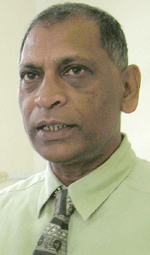Efforts intensified to maintain drainage systems
– Minister Ramsammy
THE Agriculture Ministry and the National Drainage and Irrigation Authority (NDIA) have intensified efforts to maintain drainage systems that falls under their purview and that of the municipalities, as the May/June rains persist.  “We are in the May/June rain and, indeed, we have been monitoring along the coast and all of the various drainage structures in the area of Regions Four and Five,” Agriculture Minister Dr. Leslie Ramsammy said yesterday.
“We are in the May/June rain and, indeed, we have been monitoring along the coast and all of the various drainage structures in the area of Regions Four and Five,” Agriculture Minister Dr. Leslie Ramsammy said yesterday.
In an interview, he said the focus is critical to flood prevention along the coast, specifically on the East Demerara Water Conservancy (EDWC).
He said, while the rainfall continues to intensify, the NDIA has been able to maintain the water levels of the EDWC.
Ramsammy explained that the EDWC is one that needs much attention since it cannot be allowed to get too low or too high, as that would result in people and their crops being greatly affected in many ways.
Below a certain level would lead to being without water for drinking purposes and not enough for irrigation will weaken the dam. On the other hand, if the water mark rises too much, it puts peoples’ lives at risk, as well, he said.
Ramsammy said, while every effort is being made to ensure that the EDWC is maintained, the continuous heavy rainfall threatens to make it overtop and put residents in surrounding areas at risk.
“We have to ensure we don’t allow the conservancy to go above 58 Georgetown Datum; right now it is between 56½ and 57½ ,depends on where you are measuring from. So we don’t have enough room and so any kind of intense rain will put us at risk,” he explained.
He said, because the Cunha Canal is now restricted and can only do some much, the discharge of water is highly dependent on the Kofi Canal and the Five Door sluice, both of which must be closed during high tide.
Very closely
“We have been discharging water from the conservancy on the western end. This is using Kofi, the five-door sluice and Cunha. We rely on Kofi and the five-door, both of which must be closed at high tide. This means that the people of Region Five will be watching the situation very closely,” he observed.
Ramsammy said: “We, of course, don’t want to open the Maduni and Lama, so we have not had any need to consider opening the two since the May/June rain started and we hope that we won’t have to do it, so we will be monitoring that situation.”
He noted that, presently, to make sure things are under the control of the NDIA and the Ministry, automated minute to minute checks are being carried out on the conservancy and a team is out stationed at the site to look over the EDWC.
“We have an automated station which reports continuously by the second and we do that through the computer but we also have teams in the conservancy itself that are travelling form one end to the next as we monitor that situation,” the Minister assured.
As the rains intensify, kokers and sluices continue to be monitored and even those that come under the authorities of the municipalities.
This is because several areas were subjected to flooding due the fact that three of four of the municipal pumps were out of order.
“I have had a special interest in the municipality of Georgetown and I am unable to verify whether all of the pumps are in working conditions. You will recall that with the events of December, January and February, three of the four were not working,” he said.
Not satisfied
Minster Ramsammy said he is not satisfied with the conditions of the internal drains in Georgetown and, although the main canals are in good condition, efforts will be made to enhance that of the secondary drainage systems.
Earlier this week, some of the heavy rainfall led to flash flooding and several communities in Region Six (East Berbice/Corentyne) were among the areas affected and, to date, are still covered by flood waters.
“As we speak, right now, some communities are under water, including part of Tain, Whim, Port Mourant and some Central Corentyne villages.
Water is in the rice fields and sugarcane fields. So Black Bush has water and the canefields are completely inundated but we are working on that,”
Ramsammy said.
He said most of the water in residential areas were removed and additional pumps have been deployed to discharge the remainder.
“Those pumps are operated by Guyana Sugar Corporation (GuySuCo) on the Corentyne but we had to deploy an extra five mobile pumps to those areas. So we will continue to monitor the situation and take all necessary action to ensure that whatever water remains on the ground is removed,” he added.



.jpg)










